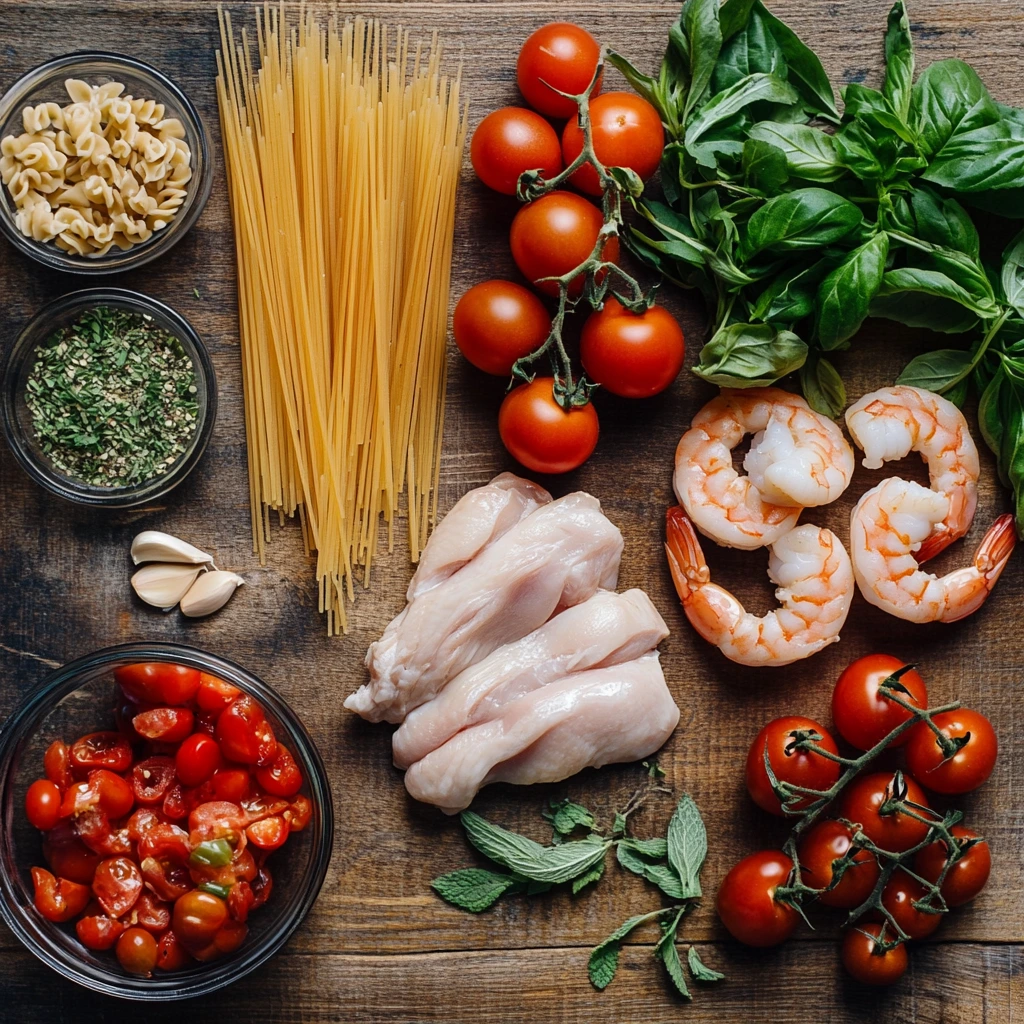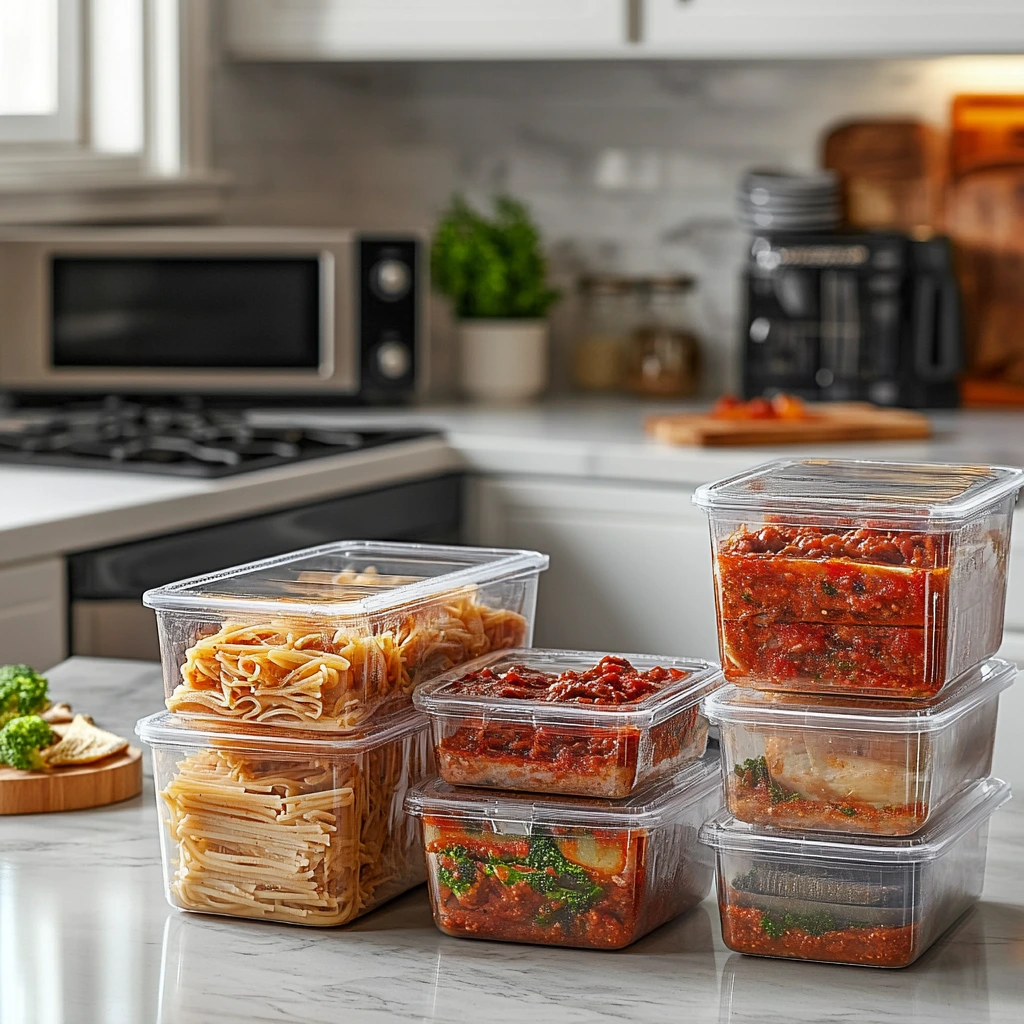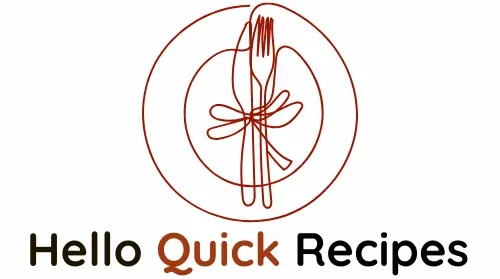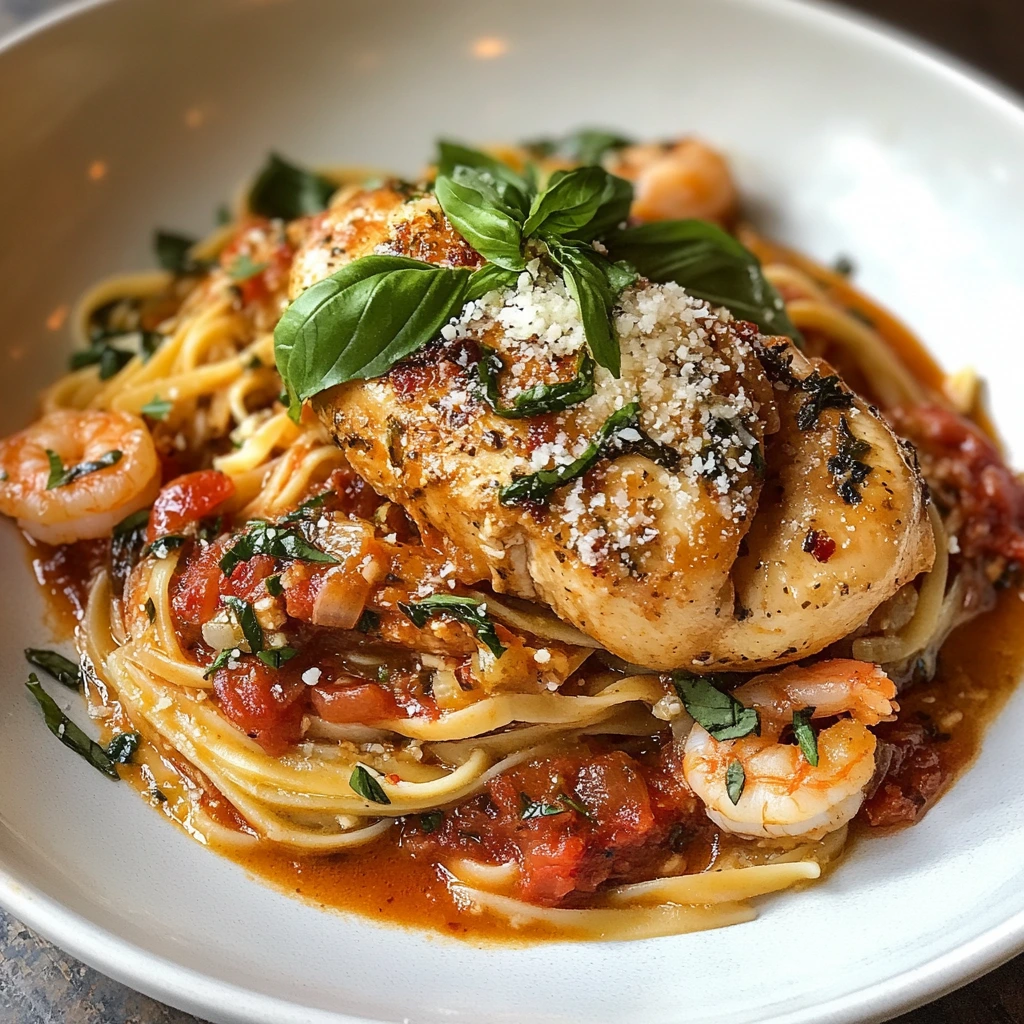Chicken and Shrimp Pasta with Tomato Sauce is a culinary delight that perfectly balances hearty flavors and rich textures. Combining the tender juiciness of chicken, the succulent sweetness of shrimp, and the tangy zest of a robust tomato sauce, this dish is a feast for the senses. It’s a versatile meal that pairs well with a range of occasions, from casual family dinners to elegant gatherings.
Its widespread appeal lies in its ability to cater to diverse palates, blending the comforting taste of classic Italian cuisine with the satisfying depth of protein-rich ingredients. Whether served with a garnish of fresh basil or a sprinkle of Parmesan cheese, this dish is a guaranteed crowd-pleaser, offering a taste of sophistication with every bite.
Table of Contents
Ingredients Breakdown

Chicken: Selection and Preparation
For this recipe, boneless, skinless chicken breasts or thighs work best due to their tenderness and ease of cooking. Fresh chicken ensures optimal flavor, but frozen chicken can be used if fully thawed. Season the chicken with salt, pepper, and optional Italian herbs, and sear until golden for a flavorful crust.
Shrimp: Types and Cleaning Methods
Large or jumbo shrimp are ideal for their firm texture. Fresh shrimp are preferred, but frozen shrimp can be used after proper thawing. To clean, peel the shell, remove the tail if desired, and devein by cutting along the back and removing the vein. Rinse under cold water.
Tomatoes: Choosing the Right Variety
San Marzano tomatoes are highly recommended for their natural sweetness and low acidity, perfect for a rich, tangy sauce. Roma or plum tomatoes are good fresh alternatives due to their meaty texture and robust flavor.
Pasta: Best Types for This Recipe
Long pasta like linguine or fettuccine pairs beautifully with the sauce and proteins, holding the flavors well. Cook the pasta al dente to prevent it from becoming mushy when mixed with the sauce.
Herbs and Spices: Enhancing Flavors
Fresh basil, parsley, and oregano bring vibrant, authentic Italian flavors. Garlic and onion form the aromatic base, while a pinch of red pepper flakes adds a subtle heat. Finish with Parmesan for a savory touch.
Health Benefits: Chicken and Shrimp Pasta with Tomato Sauce
Chicken and Shrimp Pasta with Tomato Sauce offers a variety of nutritional benefits, making it both delicious and nourishing.
Nutritional Value of Chicken and Shrimp
Chicken is a lean source of high-quality protein, essential for muscle repair and growth. Shrimp adds a low-calorie protein boost and is rich in omega-3 fatty acids, which support heart health. Both provide essential vitamins and minerals like B vitamins, zinc, and selenium, promoting overall wellness.
Benefits of Tomatoes and Herbs
Tomatoes are packed with antioxidants, particularly lycopene, which supports heart health and reduces inflammation. They also provide vitamin C, potassium, and fiber. Fresh herbs like basil and parsley are rich in vitamins A, C, and K, along with beneficial compounds that enhance digestion and immunity.
Balanced Meal Considerations
This dish combines protein, healthy fats, and carbohydrates, offering a well-rounded, balanced meal. By pairing lean proteins with fiber-rich pasta and nutrient-dense vegetables, it supports sustained energy, muscle recovery, and overall health. Adding whole-grain pasta and reducing added salt can further enhance its nutritional profile.
Step-by-Step Recipe: Chicken and Shrimp Pasta with Tomato Sauce
Preparation
- Ingredients: Gather all ingredients:
- 2 boneless, skinless chicken breasts (cut into bite-sized pieces)
- 12 large shrimp (peeled, deveined)
- 12 oz pasta (linguine or fettuccine)
- 1 can (28 oz) San Marzano tomatoes (crushed or whole, then crushed)
- 3 garlic cloves (minced)
- 1 small onion (finely chopped)
- 3 tbsp olive oil
- 1 tsp dried oregano
- 1/2 tsp red pepper flakes (optional)
- 1/4 cup fresh basil (chopped)
- Salt and pepper to taste
- Parmesan cheese (for garnish)
- Prep Work:
- Season chicken and shrimp lightly with salt, pepper, and a sprinkle of dried oregano.
- Boil water in a large pot with a pinch of salt for the pasta.
Cooking Instructions
- Cook the Pasta:
- Add the pasta to boiling water and cook until al dente according to package instructions (usually 8-10 minutes). Drain, reserving 1/2 cup of pasta water, and set aside.
- Sear the Chicken:
- Heat 2 tbsp olive oil in a large skillet over medium-high heat. Add chicken pieces and cook until golden brown and cooked through, about 5-7 minutes. Remove and set aside.
- Cook the Shrimp:
- In the same skillet, add 1 tbsp olive oil and cook shrimp for 2-3 minutes per side until pink and opaque. Remove and set aside.
- Prepare the Sauce:
- Lower heat to medium, add the remaining olive oil if needed, and sauté garlic and onion until fragrant and translucent (about 3 minutes).
- Stir in red pepper flakes (if using) and oregano, cooking for 1 minute.
- Add crushed tomatoes, season with salt and pepper, and simmer for 10-12 minutes, stirring occasionally.
- Combine Ingredients:
- Return the chicken and shrimp to the skillet, stirring them into the sauce. Add reserved pasta water if the sauce is too thick.
- Toss in cooked pasta, mixing thoroughly to coat the noodles in the sauce.
Serving Suggestions
- Plate the pasta in bowls or on a large serving platter.
- Garnish with freshly chopped basil and grated Parmesan cheese.
- Pair with a side of garlic bread or a simple green salad for a complete meal.
- Serve immediately and enjoy this comforting, flavorful dish!
Cooking Tips and Variations
When exploring variations of this dish, you might find inspiration from Cajun Shrimp Chicken Pasta, which introduces bold, spicy flavors perfect for a zesty twist. Similarly, if you’re looking to make a lighter version, consider trying Chicken and Shrimp Pasta Without Cream, which omits dairy for a healthier, yet still delicious option.
For a vegetarian alternative, swap the proteins with hearty vegetables like mushrooms or zucchini and use a rich marinara sauce for a satisfying meatless meal. For gluten-free adaptations, use gluten-free pasta varieties and ensure that your tomato sauce is free of hidden gluten additives.
Pairing Suggestions
To enhance the dining experience, this pasta pairs beautifully with a crisp white wine like Sauvignon Blanc or a medium-bodied red like Chianti. As a side dish, a green salad with a light vinaigrette or garlic bread makes for a complementary pairing. To round off the meal, consider a decadent dessert like a Philadelphia Pecan Pie Cheesecake for a rich, sweet ending.
Common Mistakes to Avoid
Overcooking Proteins
One of the most common errors is overcooking the chicken or shrimp, which can make them dry and rubbery. Chicken should be cooked until it reaches an internal temperature of 165°F (74°C), while shrimp should only be cooked until they turn pink and opaque, typically 2-3 minutes per side.
Improper Seasoning
Seasoning at the wrong time or using too little can result in a bland dish. Always season your chicken and shrimp before cooking and taste your tomato sauce as it simmers, adjusting salt, pepper, and herbs to suit your preference. Avoid adding too much salt early on, as ingredients like Parmesan can naturally add salinity.
Pasta Cooking Errors
Overcooked or undercooked pasta can ruin the texture of the dish. Always cook your pasta al dente (firm to the bite), as it will absorb some of the sauce when mixed. Avoid rinsing the pasta after cooking to retain its natural starch, which helps the sauce adhere better.
Storage and Reheating: Chicken and Shrimp Pasta with Tomato Sauce
Refrigeration Guidelines
Store leftovers in an airtight container in the refrigerator for up to 3 days. Allow the dish to cool completely before sealing to prevent excess moisture and bacterial growth.
Freezing Tips
For longer storage, freeze the pasta and sauce separately in freezer-safe containers. This prevents the pasta from becoming mushy. The dish can be frozen for up to 2 months. Thaw in the refrigerator overnight before reheating.

Reheating Methods
Reheat the dish gently to preserve texture and flavor. For stovetop reheating, add a splash of water or broth to the pan to loosen the sauce and heat on low. In the microwave, reheat in 30-second intervals, stirring occasionally. Avoid overheating to prevent drying out the proteins and sauce.
(FAQs) About: Chicken and Shrimp Pasta with Tomato Sauce
Chicken and Shrimp Pasta with Tomato Sauce:
1. Can I mix chicken and shrimp together?
Yes, mixing chicken and shrimp in a pasta dish is not only possible but also delicious. The combination of tender chicken and succulent shrimp creates a dynamic flavor and texture profile. Both proteins complement the tangy richness of the tomato sauce and the pasta’s comforting bite, making it a standout dish.
2. Is tomato sauce good in pasta?
Absolutely! Tomato sauce is a classic choice for pasta, offering a balance of acidity, sweetness, and savory depth. It pairs beautifully with a variety of ingredients, from proteins like chicken and shrimp to vegetables like mushrooms and zucchini. Tomato sauce is also versatile, allowing you to customize it with herbs, spices, and even a touch of cream or wine to suit your taste preferences.
3. What’s the healthiest sauce to put on pasta?
For a healthy pasta sauce, a simple tomato-based sauce is an excellent option. It is low in fat and calories while being rich in nutrients like lycopene, an antioxidant that supports heart health. To make it even healthier, prepare it with fresh tomatoes, garlic, and olive oil, and skip the sugar or heavy cream often added to store-bought versions. Adding fresh herbs and vegetables can further boost its nutritional value.
4. Can you add raw chicken to pasta sauce?
While it’s technically possible to cook raw chicken directly in pasta sauce, it’s not recommended unless the chicken is cut into very small pieces and the sauce is simmered long enough to fully cook the chicken to a safe internal temperature (165°F or 74°C). For better texture and flavor, it’s best to sear or sauté the chicken separately before adding it to the sauce. This method also allows you to control the seasoning and ensure the chicken remains juicy and flavorful.
Conclusion
Chicken and Shrimp Pasta with Tomato Sauce:
Chicken and Shrimp Pasta with Tomato Sauce is a dish that effortlessly combines the richness of Italian-American flavors with the satisfying textures of tender chicken, succulent shrimp, and al dente pasta. The tangy tomato sauce, infused with aromatic herbs and spices, ties it all together, making it a meal that’s both comforting and elegant.
Whether you’re cooking for a family dinner or impressing guests at a gathering, this recipe is sure to delight. Its versatility allows for endless variations, ensuring there’s something for everyone. Don’t wait, gather your ingredients, follow the steps, and savor the delicious results. This dish might just become your new favorite!

